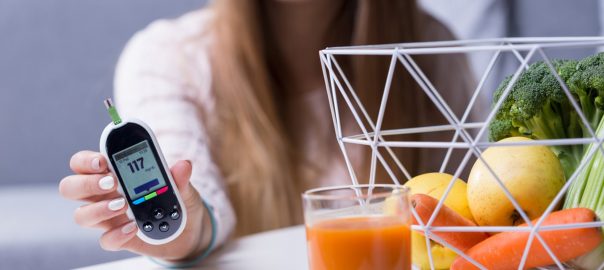
How To Control Blood Sugar Levels on a Keto Diet
Controlling Sugar Levels in our Blood
Discover what foods to eat for better health & control blood sugar levels
Many people struggle with managing their blood sugar levels – even if they don’t know it. Common problems can arise due to insulin resistance or diabetes, a condition in which the body cannot properly process glucose (sugar) in the blood. This occurs because of improper functioning or production of a hormone called insulin.
Insulin is involved in helping convert glucose from foods we eat into usable energy. However, when not enough insulin is produced or the body doesn’t respond to insulin the way it should (known as insulin resistance), glucose can remain in the blood. If this happens consistently, it is very dangerous for our health; glucose molecules that are not converted into energy can seriously damage our organs and tissues. This is why people with diabetes are at higher risk for things like heart disease, kidney damage, infections that affect the limbs, deteriorating eye health, and even nerve damage in the brain.
In this article, we cover ways that you can control your blood sugar levels effectively through a low carb diet, or keto diet.
Below are various foods and substances you can include more of in your diet due to their proven ability to improve blood sugar control.
Disclaimer: The information in this article is not intended to replace personalized medical advice. A low carb diet may not be suitable for you. Consult your health care provider before making any changes to your lifestyle or use this information at your own risk.
Cinnamon
Cinnamon can help regulate blood sugar levels because it imitates the effects of insulin. It increases the transportation of glucose from the blood into the cells, where it can be stored for energy rather than circulating in the blood. Cinnamon also helps promote the release of insulin from the pancreas, which can improve insulin sensitivity. This is especially needed in the case of diabetics or those with insulin resistance and are prediabetic, as the body does not respond to insulin the way it should. Finally, cinnamon can also improve digestion. Healthy digestion is an important component of blood sugar control as this can make it easier to process and expel excess sugar to keep blood sugar levels at normal levels.
How to Use Cinnamon
One of the best ways for people trying to control their blood sugar levels is to consume cinnamon in a glass with water first thing in the morning. You can soak a cinnamon stick in a glass of water overnight and drink it when you wake up before eating. In addition, you could mix cinnamon powder into your morning tea or coffee beverage, which adds great flavour and is a good replacement for sugar.
Cinnamon can also add bright and delicious flavours to savoury dishes. Try making a curry or stew with cinnamon and a mix of other vibrant spices, such as turmeric, allspice, cloves, curry, cumin and black peppercorn. Alternatively, you can add cinnamon to things like smoothies, yogurt, cereals or granolas.
Buy the Right Kind of Cinnamon!
Before moving on, it is imperative that we mention the importance of choosing the right kind of cinnamon, especially if you plan to consume it regularly. The most common form of cinnamon that you find in grocery stores is a variety called Cassia cinnamon, from China. Cassia cinnamon actually contains potentially unsafe levels of a toxin called coumarin. If you eat more than one teaspoon (2.6 grams) of Cassia cinnamon, you could increase your risk of liver damage, cancer and breathing problems.
The best type of cinnamon to buy is Ceylon cinnamon from Sri Lanka, also known as “True Cinnamon.” This variety contains 250 times less coumarin than Cassia cinnamon, so it is much safer for regular consumption. It also has a slightly sweeter taste, so it is not as overpowering – believe it or not, it tastes similar to cinnamon heart candies!
Shop Cinnamon products at The Low Carb Grocery!
Magnesium
Magnesium is an essential nutrient for the brain and the body, so it has many health benefits aside from regulating blood sugar levels. Those with diabetes and prediabetes are often deficient in magnesium. This explains the occurrence of insulin resistance in these individuals because magnesium plays an important role in converting glucose from the food we eat into fuel. A lack of magnesium makes our bodies less effective at using insulin, resulting in insulin resistance.
How to Use Magnesium
There are many different forms of magnesium. Some you can find in supplement form, such as magnesium chloride or magnesium oxide, and others naturally occur in certain foods. You can buy magnesium supplements in the form of liquids, dissolvable powders or pills. It is recommended to consume about 270mg of magnesium for women or 300mg for men each day.
Some dietary sources of magnesium to include in your diet are:
- Pumpkin seeds (also known as pepitas)
- Almonds
- Green leafy vegetables
- Cashews
- Peanuts
- Soymilk
- Dark chocolate (70% cacao or higher)
- Avocados
- Legumes
Be sure to discuss the benefits and risks of different forms of magnesium supplements with an expert before choosing the right one for you.
Chromium
Chromium is another essential trace mineral that we need in our diets. It is only needed in small amounts to help the body process carbohydrates, proteins and fats. It has also been shown to improve the function of insulin in the body. Essentially, it increases the activity of insulin receptors, thus increasing insulin sensitivity.
The recommended dose of chromium for diabetics is anywhere from 200mcg to 1000mcg a day. Speak with a health care practitioner about including a chromium supplement in your diet to improve blood sugar control. You can also include more foods in your diet that are naturally high in chromium, such as these:
- Broccoli
- Green beans
- Beef
- Poultry
- Seafood
- Nuts and seeds
- Egg yolks
Chromium is also found in things like potatoes, whole grains and fruits such as grapes, oranges and apples; however, these are not very low carb-friendly choices.
Healthy Fats
Fat is the longest lasting fuel source that our bodies and brains can use. On the other hand, glucose from carbohydrates is burned very quickly, which is why it can cause a roller coaster ride of energy levels if it is the main source of fuel in our diet.
The best way to avoid blood sugar spikes and crashes is to switch to a different fuel source – healthy fats. These include foods such as coconut oil, olives, avocados and fatty fish. Healthy fats provide our bodies with enough energy to last for hours so we don’t experience spikes and crashes, and they improve the absorption of certain nutrients. In addition, omega-3 fatty acids found in healthy fat sources reduce inflammation, which can improve insulin and satiety signaling in the body.
Try to replace unhealthy fats found in things like vegetable oils, packaged food products, restaurant and fast food meals, margarine and grain-fed meats with the healthy fat options.
In addition, you can speak with your health care practitioner about a low carb, high fat (LCHF) or ketogenic diet, as these fat-based diets have shown many benefits for those struggling with diabetes and have trouble maintaining a healthy weight.
Find more resources and information about these lifestyles on our low carb lifestyle blog.
Adaptogens
Adaptogens are plants and herbs that have reparative effects on the body. They get their name from their ability to “adapt” to the different needs of the body at the time they are consumed. They may either have a stimulating or relaxing effect, with the overall goal of stabilizing the body’s systems and returning it to its natural state of homeostasis. In this state, the body can function optimally and combat stressors (including excess blood sugar).
Adaptogens are effective at stabilizing hormones such as cortisol, which can throw the body out of balance. Excess cortisol in the blood can make it harder to process sugar and lead to more sugar cravings. Adaptogenic herbs such as ginseng, ashwagandha, maca root, reishi and holy basil have been shown to be effective at stabilizing cortisol levels in the body. You should also aim to reduce dietary stressors such as caffeine, processed foods and high sugar foods.
We recommend making tea from chaga mushroom chunks. This tea/herbal remedy dates back thousands of years, and is filled with loads of minerals and vitamins, as well as antioxidants and phytonutrients. Changa tea is said to help weight-loss, tuberculosis, bad circulation and even treatment of some cancers due to the content of betulinic acid. With all these benefits, its easy to see why chaga tea has become so popular.
Note: It’s also important to manage stress in other areas of life by including exercise, yoga and other activities that you enjoy in your daily life.
Other Tips to Control Your Blood Sugar Levels
Eat Regularly
Eating at regular time intervals every day can help the body get into a natural rhythm. This has not only proven effects for blood sugar control but can also aid in other things like sleep quality, energy levels and metabolism.
Try to eat three meals a day, 3-5 hours apart, with a couple healthful snacks in between – and best to do this at the same time every day. Also be sure to eat about the same amount of food every day at each meal and snack. If you have diabetes, the body isn’t able to respond to drastic changes in blood sugar levels, so it is best to maintain a similar eating pattern that the body can easily predict. Your doctor will likely recommend how many carbohydrates you can eat every day and at what times. Typically, carbohydrates are better metabolized after a workout or when the body’s metabolism naturally peaks in the late afternoon (around 8-10 hours after waking).
Include More Fibre in Your Diet
Fibre is essential for stabilizing blood sugar levels. This is because fibrous foods are digested more slowly by the body, allowing for a more timed release of glucose into the blood. High fibre foods are also usually low in sugars, which can help prevent blood sugar spikes.
Aim to include leafy green vegetables in at least one of your meals each day. These are high in many of the nutrients previously mentioned in this article and provide a good dose of fibre. Some other high fibre, low carb foods include:
- Ground flaxseed
- Chia seeds
- Cruciferous vegetables (broccoli, cauliflower, artichokes, Brussels sprouts, etc.)
- Celery
- Cucumber
- Psyllium husk – this can be added to smoothies, cereals, and baked goods!
- Oat fibre
- Nuts
Also check out products like Smart Sweets and Miracle Noodles – tasty, high-fibre alternatives to traditionally high-glycemic foods like candy and pasta.
Eat Balanced Meals
A balanced meal includes fibre, protein and healthy fats. Try to include one source of each macronutrient at each of your meals and snacks for better digestion and blood sugar control. Combining these different elements will help stave off hunger and allow your body to process nutrients optimally. It will also keep you energized until your next meal to avoid excessive snacking that can occur when our blood sugar levels drop.
Share How You Managed to Control Sugar Intake
We hope that this article has provided you with some ideas to manage your blood sugar intake. If you would like to share your thoughts or experiences, head over to our Facebook and Instagram pages.
We also love to read and respond to our Google Reviews, so please take a moment to share your experiences with The Low Carb Grocery over there! And lastly, subscribe to our weekly email newsletter for the most up to date keto news and low carb health food sales!
Good luck with your fight against sugar intake!






